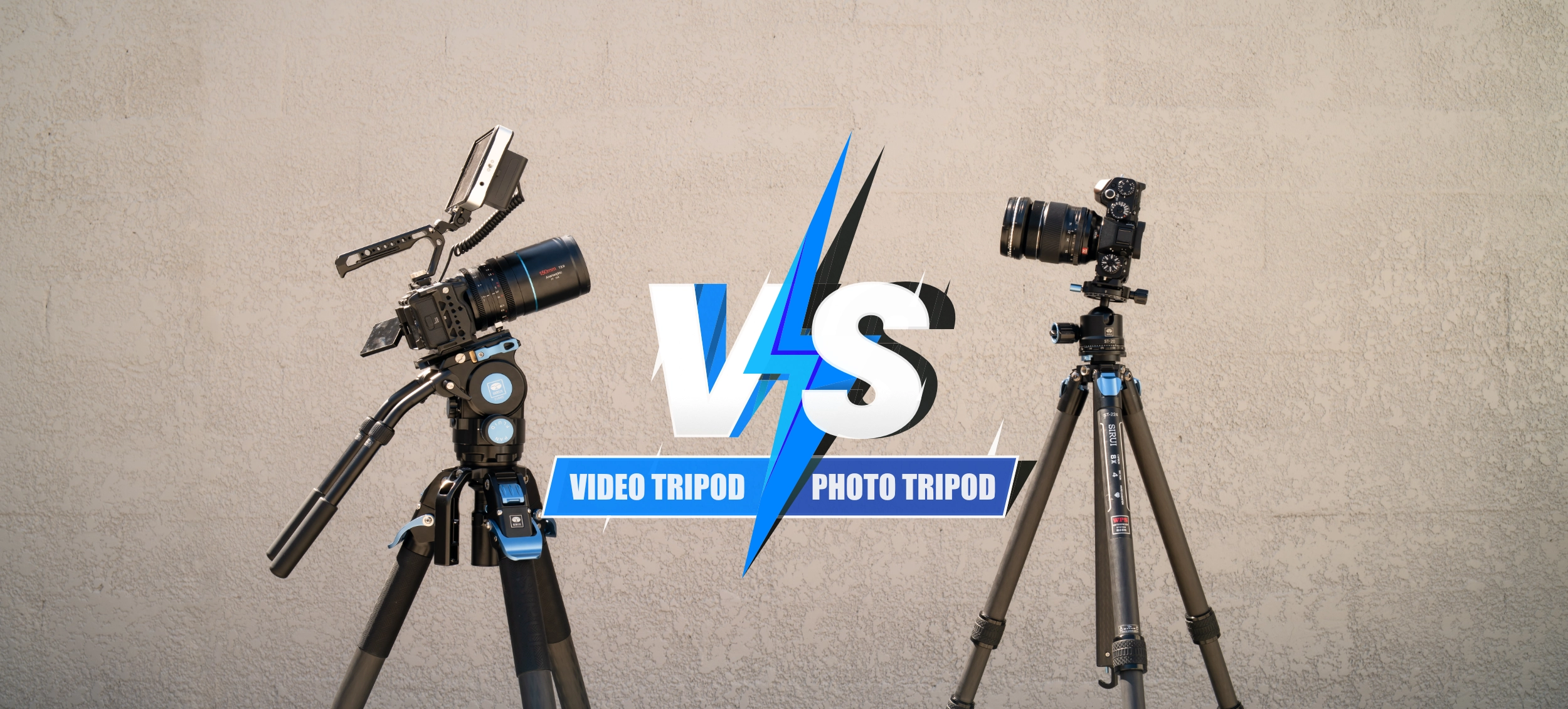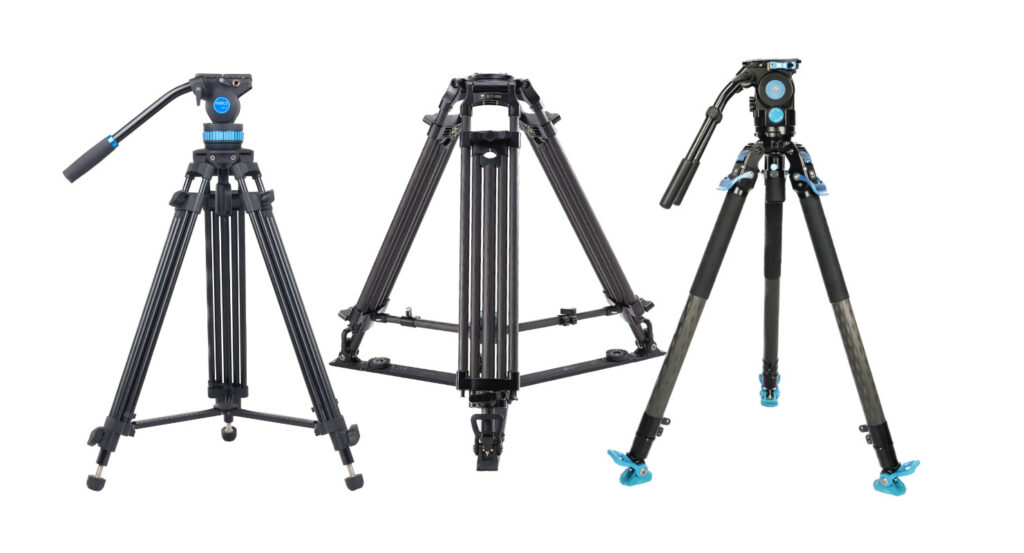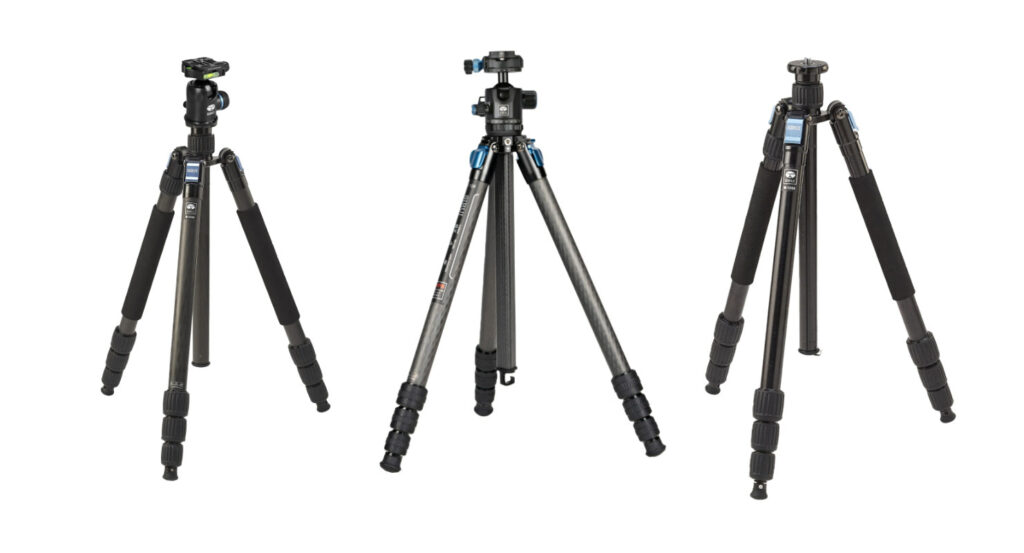
In the realm of visual arts, whether you're a professional videographer or a passionate photographer, having the right equipment is paramount. Central to this is the choice between a video tripod and a photography tripod. While both serve the purpose of stabilizing your camera, they cater to distinct needs and offer unique features. In this comprehensive guide, we'll delve into the nuances of video tripods and photography tripods, helping you make an informed decision that aligns perfectly with your creative vision.
What is a Video Tripod?
In the world of videography, capturing the perfect shot requires not only skillful handling of the camera but also the right equipment. One indispensable tool in a videographer's arsenal is the video tripod. But what exactly is a video tripod, and why is it crucial for achieving professional-quality videos? In this comprehensive guide, we'll delve into the intricacies of video tripods, exploring their purpose, features, types, and how to choose the perfect one for your specific needs.
A video tripod is a three-legged support system designed to provide stability and minimize camera shake during video recording. It serves as a steady platform for your camera, allowing you to capture smooth and steady footage, even in dynamic or challenging shooting conditions.
In videography, stability is paramount. Whether you're shooting a cinematic masterpiece, a vlog, or a product review, shaky footage can detract from the overall quality of your video. A video tripod offers the stability needed to produce professional-looking videos that leave a lasting impression on your audience.
Key Features of a Video Tripod for Superior Filmmaking
Fluid Head Tripods: Panning and Tilting Smoothness
Fluid head tripods are equipped with a specialized fluid-filled chamber that allows for seamless panning and tilting motions. This feature is invaluable for capturing dynamic shots that require smooth, controlled movements.
Ball Head Tripods: Flexibility and Quick Adjustments
Ball head tripods offer a high degree of flexibility, allowing for quick adjustments in various directions. They are ideal for videographers who need to change angles swiftly to capture different perspectives.
Tabletop Tripods: Portability and Convenience
Tabletop tripods are compact, lightweight, and designed for on-the-go videography. They provide a stable platform for your camera when a full-sized tripod is impractical or unnecessary.
Choosing the Right Video Tripod: A Buyer's Guide
Selecting the perfect video tripod requires careful consideration of several key factors:
Weight Capacity: Supporting Your Gear
Ensure that the tripod you choose can support the combined weight of your camera, lenses, and any additional accessories you plan to use. Exceeding the weight capacity can lead to instability and potential damage to your equipment.
Height Adjustability: Finding the Right Perspective
Consider the height range of the tripod. It's essential to find a model that allows you to achieve your desired shooting perspective, whether it's eye-level, low-angle, or overhead shots.
Material Matters: Strength vs. Weight
Tripods come in various materials, with aluminum and carbon fiber being the most common. Aluminum tripods are durable and cost-effective, while carbon fiber offers a balance between strength and weight savings, making it an excellent choice for travel videographers.
Leg Locks: Security and Ease of Use
The type of leg locks on a tripod can affect how quickly you can set up and adjust your equipment. Twist locks are secure and easy to use, while lever locks provide rapid deployment but may require occasional maintenance.
Additional Features: Monopod Conversion, Spreader, and more
Some video tripods offer additional features, such as the ability to convert one leg into a monopod, spreader systems for increased stability, and compatibility with various tripod heads. Assess these features based on your specific needs.
Setting Up and Using Your Video Tripod: Pro Tips for Stability
Achieving stability with your video tripod requires proper setup and technique. Follow these tips to get the best results:
- Always ensure that the tripod is on a stable surface.
- Extend the tripod legs evenly to maintain balance.
- Use a spirit level or bubble level to ensure the tripod is level.
- Gradually pan and tilt to avoid jerky movements.
- Invest in quality tripod feet or spikes for outdoor use on uneven terrain.
Maintaining Your Video Tripod: Ensuring Longevity
To prolong the lifespan of your video tripod:
- Regularly clean and lubricate the moving parts.
- Store the tripod in a dry, cool place to prevent moisture damage.
- Inspect for loose screws or damaged components and address them promptly.
- Avoid overloading the tripod beyond its weight capacity.
What is a Photography Tripod?
A photography tripod is a three-legged stand primarily used to stabilize a camera or other photographic equipment. It provides a stable base, reducing the risk of camera shake, which is especially crucial in situations where long exposure times are necessary or when using telephoto lenses. By keeping the camera steady, tripods ensure that images are sharp, clear, and devoid of any blurriness caused by inadvertent movements.
Types of Photography Tripods
Traditional Tripods
Traditional tripods are the most common and versatile type. They typically consist of three extendable legs with adjustable height settings, a central column, and a head that securely holds the camera. These tripods come in various sizes and materials, catering to different photography styles and preferences.
Travel Tripods
Designed with portability in mind, travel tripods are lightweight and compact, making them ideal companions for photographers on the move. They often feature collapsible legs and a more streamlined design without compromising on stability. Travel tripods are perfect for outdoor shoots, hiking trips, or situations where space is limited.
Mini Tripods
Mini tripods, also known as tabletop tripods, are small, portable stands that can be placed on a flat surface. While they may not offer the same height and stability as their larger counterparts, they are incredibly versatile and can be used for low-angle shots, time-lapses, or as makeshift stabilizers in tight spaces.
Choosing the Right Photography Tripod: A Buyer's Guide
Selecting the perfect video tripod requires careful consideration of several key factors:
Material Matters: Aluminum vs. Carbon Fiber
Aluminum: The Sturdy Workhorse
Aluminum tripods are renowned for their robustness and durability. They offer excellent stability and are well-suited for studio setups or outdoor shoots where weight is less of a concern. Additionally, they tend to be more budget-friendly, making them a popular choice for amateur photographers or those just starting out in the field.
Carbon Fiber: Lightweight Elegance
On the other hand, carbon fiber tripods have gained immense popularity for their lightweight yet sturdy construction. They are ideal for photographers who are constantly on the move or engage in outdoor adventures where every ounce counts. Although they come with a higher price tag, the weight savings and increased portability are often worth the investment.
Height Adjustability: Reaching New Heights
A tripod's ability to extend to various heights is crucial for achieving diverse perspectives. Look for a model with adjustable legs and a center column that provide both versatility and stability. Whether you're shooting a towering skyline or a macro subject at ground level, having the right height adjustments at your disposal is paramount.
Leg Lock Mechanisms: Security in Every Lock
Twist Locks: Quick and Secure
Twist locks are a popular choice due to their simplicity and speed. They allow for rapid setup and takedown, ensuring you never miss a moment. The twisting motion engages or disengages the leg sections, providing a secure hold even in challenging conditions.
Lever Locks: Rapid Deployment
Lever locks are favored for their ease of use, particularly when you need to adjust the tripod's height frequently. With a quick flick of a lever, you can extend or retract the legs swiftly. This mechanism provides a high level of convenience, especially in dynamic shooting environments.
Weight Capacity: Balancing Act
Consider the weight of your camera and any additional accessories you plan to mount on the tripod. Ensuring that the tripod can comfortably support the combined weight is crucial for stability and preventing any accidental topples. Always opt for a model with a weight capacity that exceeds your equipment's heaviest configuration.
Stability Features: Weathering the Elements
Spiked Feet: Tackling Uneven Terrain
For outdoor enthusiasts and landscape photographers, spiked feet offer enhanced stability on uneven surfaces like rocky terrain or soft ground. They provide a firm grip, preventing any wobbling or shifting during long exposure shots.
Rubber Feet: Surface-Friendly Support
Rubber feet are the go-to choice for indoor or urban environments. They offer excellent traction on smooth surfaces, minimizing any potential slippage. Additionally, they're gentle on delicate floors, making them suitable for indoor studios or architectural photography.
Maintaining Your Photography Tripod: Ensuring Longevity
To prolong the lifespan of your video tripod:
- Regularly clean and lubricate the moving parts.
- Store the tripod in a dry, cool place to prevent moisture damage.
- Inspect for loose screws or damaged components and address them promptly.
- Avoid overloading the tripod beyond its weight capacity.
Understanding the Fundamental Differences
Before diving into the specifics, it's crucial to grasp the foundational disparities between video tripods and photography tripods. Video tripods are engineered to facilitate smooth and controlled movements, ideal for capturing dynamic footage. On the other hand, photography tripods are designed to provide stability for still images, prioritizing quick setup and precise framing.
Key Features of Video Tripods
Payload Capacity and Fluid Head
Video tripods are characterized by their higher payload capacity, accommodating the weight of not only the camera but also additional accessories like microphones and external monitors. The inclusion of a fluid head allows for seamless panning and tilting motions, ensuring buttery-smooth transitions in your videos.
Pan and Tilt Movements
The pan and tilt movements of a video tripod are meticulously calibrated for cinematic shots. This precision is essential for capturing sweeping landscapes or tracking a subject in motion without any jarring disruptions.
Height Adjustment Mechanism
A video tripod typically features a robust height adjustment mechanism that allows for precise control over the camera's elevation. This is particularly advantageous when you need to vary perspectives or shoot from unconventional angles.
Spreader Systems for Stability
To maintain stability during dynamic shots, video tripods often incorporate spreader systems. These mechanisms enhance the tripod's rigidity, preventing wobbling or swaying during rapid movements.
Advantages of Opting for a Video Tripod
When embarking on videography projects, a video tripod proves invaluable. Its specialized features cater to the nuanced demands of cinematic recording, ensuring professional-grade results.
When to Choose a Photography Tripod
Importance of Quick Setup for Photographers
Photographers frequently find themselves in fast-paced environments where moments are fleeting. A photography tripod's swift setup is a game-changer, allowing for rapid deployment and capturing of decisive moments.
Compactness and Portability
For photographers on the move, portability is paramount. Photography tripods are engineered to be lightweight and compact, facilitating easy transportation without compromising on stability.
Load-Bearing Capacity for Different Cameras
Photography tripods come in a variety of models, each tailored to support different camera weights. This versatility ensures that your chosen tripod can accommodate your specific camera setup.
Specialty Tripods for Unique Photography Styles
Certain photography styles, such as macro or architectural photography, may require specialized tripods. These are designed with features like precise height adjustment and low-angle shooting capabilities to cater to these unique needs.
Choosing Your Creative Companion
In conclusion, the choice between a video tripod and a photography tripod ultimately boils down to the type of visual content you aim to create. If your focus is on capturing dynamic motion sequences, a video tripod is the clear winner. Conversely, for still images that demand impeccable stability, a photography tripod is the superior choice. Remember, each tool is tailored to enhance specific aspects of your creative process, so choose wisely and let your vision unfold through your lens. Happy shooting!

Professional Video Tripods | BCT | SVT | SH Series

